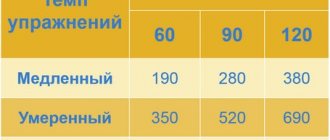Often women, in pursuit of an ideal figure, choose sports as a method of losing weight. Some prefer fitness, gymnastics, while others prefer running. Running, firstly, does not require any special imagination or troubles, and, secondly, it does not require any investments in the form of dumbbells, horizontal bars and expanders.
At the same time, women who run are concerned: is this sport effective as a calorie burner? How long should you run in the morning? How many calories are burned when running? So, the time has come to dot all the i’s.
Where does energy come from in the body and what are calories?
All consumed products consist of proteins, carbohydrates, fats, vitamins, various trace elements and minerals. In the body, everything consumed is broken down: digestive enzymes break down biopolymers into small components in the form of monomers. The chemical bond of molecules is broken and, thus, energy appears - those same hated calories.
What is a calorie? This is the quantity by which energy is measured, it is a unit of heat. With one such unit of heat, one gram of liquid can be warmed by exactly one degree. Calories measure the entire energy value of food, that is, they mean the energy that the body receives by assimilating the consumed product.
Table: Calorie consumption in 10 minutes
| Weight→ Temp↓ | 60 kg | 65 kg | 70 kg | 75 kg | 80 kg | 85 kg | 90 kg | 95 kg |
| 8 min/km | 69 | 74,8 | 80,5 | 86,3 | 92 | 97,8 | 103,5 | 109,3 |
| 7 min/km | 85,2 | 92,3 | 99,4 | 106,5 | 113,6 | 120,7 | 127,8 | 134,9 |
| 6 min/km | 96 | 104 | 112 | 120 | 128 | 136 | 144 | 152 |
| 5 min/km | 117,6 | 127,4 | 137,2 | 147 | 156,8 | 166,6 | 176,4 | 186,2 |
| 4 min/km | 150 | 162,5 | 175 | 187,5 | 200 | 212,5 | 225 | 237,5 |
As we can see, every minute, kilogram, kilometer matters for burning calories.
However, this table does not take into account running technique, route, or heart rate zones. Therefore: how many calories are burned when running in each specific case is an individual result.
How many calories does 1 km of running burn?
After running 1 kilometer in the morning, you can hope that you managed to get rid of 50-100 calories. It is impossible to give a more specific figure, since body weight, running tempo, the terrain of the treadmill, and a number of other factors play a role here. Approximately the calculation is done as follows: light running burns 1 calorie per 1 kilogram of weight. That is, when jogging one kilometer for 5-6 minutes, taking into account a flat surface, a woman weighing 50 kilograms will burn about 50 calories, a woman weighing 90 kilograms will burn 90 calories, and so on.
All about calories
A calorie is a unit of heat. This term does not apply to the SI system, and its name and definition were given by the physicist I. Wilke in the 18th century. 1 calorie is equal to the amount of heat required to raise the temperature by 1 degree 1 ml of water.
The calorie content of a product is understood as the amount of energy a person receives when a given product is fully absorbed.
The human body is not able to fully absorb any product. Therefore, there is also a separate concept – “digestibility”. Fats, carbohydrates, and proteins have different digestibility. This should be taken into account when developing a diet. For example, 50 g of gainer diluted in milk can be absorbed by no more than 70%. Moreover, the characteristics of your body can increase or decrease this indicator.
How many calories do 5K and 10K runs burn?
There is a simple formula in weight loss methods: multiply the weight of the runner by the kilometers covered. The resulting answer will be the number of calories burned. This formula works when running short distances, from 5 to 10 kilometers. Its disadvantage is that it does not take into account the relief, the pulse, therefore, it will only give an approximate figure.
According to the formula, it is obvious that a woman weighing 70 kg will spend approximately 350 calories in a 5 km run, and 700 in a 10 km run. A person weighing 100 kg will spend 500 calories in the same 5 km, and 1000 in a 10 km run. Sometimes with this When calculating, real consumption figures become far from the truth, because the intensity of the load on the body differs due to the individual characteristics of the body and the terrain.
Not everyone knows, but calories are burned even after jogging. The fact is that the body, tired of training, requires an increased portion of energy, and therefore “gets” it from the body. Of course, in order for energy to be obtained from already existing “deposits”, it is necessary to suspend the active consumption of calories from the outside. In other words, you need a diet.
How to fight calories with running
To calculate the amount of energy consumed, you will need several different parameters: metabolism, age, weight, duration, intensity and others. Accurate calculations are necessary to understand how quickly the weight loss process will progress. When you spend more than what you receive, a person becomes slimmer, bigger, and several plus sizes appear in clothes and unpleasant sensations when looking in the mirror. The correct balance between consumed and expended energy is the key to a beautiful waist and an attractive silhouette.
The approximate amount can be determined using three main ones: speed, duration and weight of the athlete. On average, a 100 kg man per hour will spend 900-1200 kilocalories while jogging. A woman is 15% smaller, taking into account her lower body weight. About 250-500 Kcal are burned in 30 minutes. To a lesser extent, the indicator depends on the intensity, and to a greater extent on the weight category of the runner.
Calorie consumption when running is uneven. In the first 10-15 minutes, the body spends fresh carbohydrates, which did not have time to be deposited, but was reserved for vital processes. Another 10-15 minutes are spent on glycogen, produced by liver cells and responsible for processing reserves. After 30 minutes, adipose tissue is broken down to produce an energy resource.
Good to know: The first half hour a runner spends daily resources, after that he begins to lose fat deposits
How to lose weight effectively
Just running is a trifle. But in order to lose weight profitably. Additional efforts will be required in the form of compliance with the rules.
- You should finish your run by gradually switching to slow running. After this, you need to switch to fast walking, and then to slow walking. This method will restore your heart rate and make your jogging more efficient.
- When a person runs, his body should be slightly inclined. In this case, it is better to press your hands to your sides, bending them at the elbows. The runner lowers his foot either entirely or just the toe.
- The movement should be smooth. You should not allow any jerks or slowdowns until the end of the workout.
- You need to breathe “according to the instructions”: through your nose and evenly. Gasping for air is not the best solution. It won’t take long to undermine the heart and create additional stress on the lungs.
- The terrain should be alternated: weight loss will happen faster. If you constantly run on a flat park strip, then soon your body will get used to it and will treat jogging as a simple walk.
- Classes must be held regularly, including in compliance with a single time schedule. Advice for beginners: you need to start training for 5-10 minutes 3-4 times a week.
About the balance of consumption and consumption
Sport is not a panacea. It is impossible to eat foods whose calorie content is off the charts, hoping that an evening jog will help get rid of the consequences of delicious food. For example, a bottle of Coca-Cola with a volume of 0.33 liters and a calorie content of 200 units will cost a person 10 minutes of intense training. Without preparation it is difficult to maintain such a pace.
800-1200 Kcal are spent on vital processes, depending on age, weight and lifestyle. Above - stored in body fat or must be burned during exercise. If the total caloric content of the diet exceeds the permissible 1000 Kcal by 500, it will take about 60 minutes of interval running. Moreover, long distances are not recommended for beginners and overweight people. This is too much stress for the heart and body. A body that has been suddenly subjected to severe stress may be in a state of stress, which means that the burning of reserves will be slower than with a normal level of physical activity.
When introducing sports into your life, you need to understand that only in combination with a healthy diet and normalization of eating habits can you achieve results.
How to lose belly fat
Here you need to immediately make a reservation: it does not happen that during physical activity only one part of the body loses weight. In other words, if a woman has a large belly and breasts, then her bust will shrink along with her belly, even if she doesn’t want it to. However, some things can be corrected, for example, if you review your diet.
- It is urgent to reconsider your diet, because more than 70% of success depends on nutrition. First, you need to reduce calories and switch to healthy foods. At the same time, it is important to consume more fiber and proteins: fiber removes toxins and excess fluid, and proteins saturate well with low calorie consumption. The belly decreases precisely due to the effective cleansing of the intestines from toxins. Accordingly, with physical activity the effectiveness of the method increases significantly.
- Drinking at least two liters a day of clean water is a rule for effective weight loss. Water washes away poisons and reduces appetite, and during intense physical activity it replenishes fluid loss in the body.
- To lose belly fat, it is important to breathe correctly when running. Only through the nose and straight!
Rules for daily running
Running for 30 minutes may not bring any results if you do not follow special rules:
- The body has the ability to adapt to any load. Therefore, most likely, when running to lose weight, in the first few weeks (4-7 weeks) you will be able to lose up to 10 kg with constant exercise, but then this process will slow down or stop altogether. Thus, the load must constantly be increased by adjusting the speed or duration.
- Find quality running shoes for yourself. Specialized orthopedic sports shoes help the foot and knee joint cope with the intense stress that they suffer during prolonged running, even with relatively light loads.
- It is very important before starting classes (even if you are an advanced runner) to do a short gymnastic warm-up. 7-10 minutes of exercise in the morning will help the body wake up and prepare for physical activity. In addition, warming up helps optimize the load on the spine.
- Control the duration of your run and its speed. If you feel unwell, out of breath, or experience pain in your arms, legs, or back, you should stop running. In cases where your health does not allow you to run for 30 minutes a day, replace such training with Nordic or race walking - no less effective exercises.
This is interesting
- [uaf_vkcount url='https://beginogi.ru/skolko-kaloriy-szhigaet-beg-na-meste-doma-ili-kak-begat-doma-bez-begovoy-dorozhki/']
To find out how many calories running in place burns, check out the article on our website
- [uaf_vkcount url='https://beginogi.ru/rashod-kaloriy-pri-bege/]
If you want to lose weight, you may be interested in the article on calorie consumption when running
- [uaf_vkcount url='https://beginogi.ru/kakie-krossovki-dlya-estestvennogo-bega-luchshe/']
Find out which running shoes are best in our article.
If you work out in the gym, go to a fitness club, or get other physical activity besides running, then you are allowed to train less often - for example, every other day. This will in no way detract from the effectiveness of the training.
What are the benefits of running
In addition to losing weight, running brings great benefits to the body. So, for example, during regular running training the following happens to the body:
- Running can use all muscle groups, including loading joints and ligaments. This means that the entire body is pumped.
- A person's heart beats faster, which in turn pumps blood through their veins faster. Consequently, there is a greater flow of oxygen into all tissues and organs, and the same applies to other nutrients. All organs work better, and the body heals, resembling a well-oiled mechanism.
- When running, a large amount of sweat is released, and with it a lot of harmful salts, toxins and wastes.
Features of training training
You can often hear the opinion that running makes the leg muscles larger, so this sport can hardly be considered useful if you need to lose weight in your thighs and calves. However, not everyone knows that leg muscles can be pumped up by running in just six months of training.
If your goal is to lose weight, just 3 months of jogging at a time convenient for you will be enough. Moreover, you don’t need to run every day - the muscles are overloaded, and the result worsens. To consistently lose calories, run 3 times a week for a couple of hours. You can eat after class only 50 minutes later, and the menu must include protein foods, as well as sour vegetables and fruits, cereals, and dairy products. This approach to training will significantly speed up the weight loss process!
How to run
- You can’t overload yourself from the very beginning: only when all the muscles begin to get used to it. You can increase the load. You shouldn’t overestimate yourself: it’s better to increase the distance by 200-300 meters every day than to immediately give a breakthrough and then quit training for a couple of weeks.
- It is important to periodically alternate the terrain, that is, the terrain of the treadmills. For two days let it be the perfectly smooth asphalt of a park area, the next two – a not-too-flat clearing, and two more days – a hilly area in nature.
- Stretching is required. Lunges, bends and other exercises should be done at least several times after running. This is done to ensure that the muscles recover after running.
- Running exercises are unlikely to bring much benefit if you run for the allotted time, and the rest of the time you basically lie down or lead a purely sedentary lifestyle. You need to move more: walk home from work, climb the stairs instead of taking the elevator.
- In order for running exercises to be of great benefit, you need to do them either in the morning, before meals, or two hours after eating, before you feel brutal hunger. Experts say that it is in this state that the body is exposed to stress and spends subcutaneous fat deposits much more intensively.
Losing weight is not an easy process, and running can help with this. The main thing is to run correctly. Having reviewed all the proposed recommendations, you need to take note of them and start right from tomorrow morning, without waiting for “next Monday”.
How much should you run to lose weight?
The duration of the workout also plays an important role. To achieve your goals, you should not exceed 60 minutes of running. Training for more than an hour will not only overwork the body as a whole, which, on the contrary, will slow down weight loss, but also begin to burn muscle fibers. But there is no point in training at all for less than 20 minutes.
The optimal running time for weight loss is considered to be 40-50 minutes.
To run effectively, it is important to take less rest without lowering your heart rate, but it is not necessary to run at the same pace. Interval jogging is also suitable for fat burning, in which you spend more time running and a little less time walking.
You can run both outside and on a treadmill in the gym. Special simulators are adapted to set the angle of inclination - to simulate climbing uphill. This method is perfect for interval training; instead of resting while walking, climb uphill. By increasing the load, you can burn more calories, and also put more stress on your buttocks and hamstrings.










